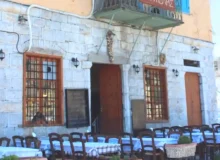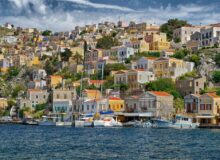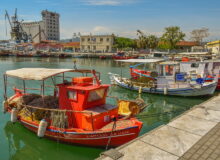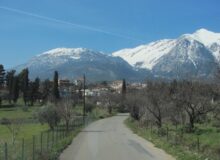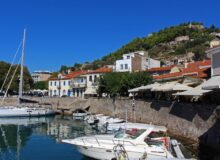The See Greece guide to the island of Patmos with a brief history and travel information on how to get there by ferry or by air and what to see and do.

Introduction to Patmos
The Greek island of Patmos, part of the Dodecanese, is a destination steeped in history, spirituality, and natural beauty. Known as the “Island of the Apocalypse,” it is famous as the place where St. John the Divine wrote the Book of Revelation. Beyond its religious significance, Patmos offers stunning landscapes, charming villages, and a serene atmosphere that attracts travelers seeking both cultural enrichment and relaxation.
This guide covers everything you need to know about Patmos, including its location, history, top sights, the best time to visit, and how to get there by air and ferry.
Where is Patmos Located?

Patmos lies in the southeastern Aegean Sea, between the islands of Leros and Ikaria. It is one of the northernmost islands in the Dodecanese group, situated approximately 55 km (34 miles) north of Leros and 40 km (25 miles) southwest of Samos. Despite its small size—just 34.6 square km (13.4 square miles)—Patmos has a rich cultural heritage and a dramatic coastline with secluded coves and crystal-clear waters.
A Brief History of Patmos
Patmos has a long and fascinating history, shaped by its strategic location and religious importance.
Ancient and Byzantine Periods
– In antiquity, Patmos was a place of exile due to its remote location. The Romans used it as a penal colony, and it was here that St. John the Apostle was exiled in 95 AD under Emperor Domitian.
– During his exile, St. John is said to have received the visions that became the Book of Revelation (the Apocalypse) in the Holy Cave of the Apocalypse.
– After the fall of the Roman Empire, Patmos declined in importance until the 11th century, when the Byzantine Emperor Alexios I Komnenos granted the island to the monk Christodoulos Latrinos.
The Monastery of St. John and Medieval Patmos
– In 1088, Christodoulos founded the Monastery of St. John the Theologian, which became a major religious and cultural center. The monastery fortified the island, protecting it from pirate raids.
– Over the centuries, Patmos remained under Byzantine and later Venetian influence before falling under Ottoman rule in the 16th century.
Modern Era
– In 1912, Patmos was occupied by Italy during the Italo-Turkish War and remained under Italian control until 1947, when it was reunited with Greece along with the rest of the Dodecanese.
– Today, Patmos is a UNESCO World Heritage Site, recognized for its religious significance and well-preserved medieval architecture.

What to See and Do on Patmos
Despite its small size, Patmos offers a wealth of historical, cultural, and natural attractions.
1. The Monastery of St. John the Theologian
Perched atop Chora (the island’s capital), this imposing fortress-like monastery dominates the skyline. Inside, visitors can explore:
– The main church, with stunning frescoes and icons.
– The treasury, housing priceless manuscripts, religious artifacts, and Byzantine jewels.
– The library, which contains over 1,000 manuscripts, including rare medieval texts.
2. The Cave of the Apocalypse
A short distance from Chora, this sacred cave is where St. John is said to have received his divine revelations. A small chapel now encloses the site, and visitors can see the fissure in the rock from which the voice of God supposedly spoke.
3. Chora (Hora)
Patmos’ capital is a maze of whitewashed houses, narrow alleys, and medieval mansions. Highlights include:
– The Square of Agia Levia, a picturesque spot with cafes and views of the monastery.
– Traditional architecture, including the 17th-century Simantiri House.
– Boutiques and artisan shops selling handmade jewelry, ceramics, and religious icons.

4. Skala (The Port Town)
Skala is the island’s main harbor and commercial center. Here, you can:
– Stroll along the waterfront with its cafes and tavernas.
– Visit the Church of Agios Nikolaos, with its distinctive blue dome.
– Explore the Patmos Municipal Market for local products.
5. Beaches
Patmos has several beautiful beaches, ranging from organized resorts to secluded coves:
– Psili Ammos – A golden sandy beach accessible by boat or a short hike.
– Lambi – Known for its colorful pebbles and clear waters.
– Kampos – A family-friendly beach with tavernas and water sports.
– Grikos Bay – A tranquil spot with shallow waters, ideal for swimming.
6. Boat Trips and Nearby Islands
Many visitors take boat excursions to:
– Lipsi – A small, peaceful island with pristine beaches.
– Arki and Marathi – Tiny islets known for their untouched beauty.

Best Time to Visit Patmos
The ideal time to visit Patmos depends on your preferences:
– May to June & September to October: The best months for pleasant weather, fewer crowds, and lower prices. Spring brings blooming flowers, while autumn offers warm seas.
– July and August: Peak season, with hot temperatures and busy streets, especially during the August 15th religious festival.
– April and November: Quieter, but some businesses may be closed.
Patmos is particularly special during Easter, when the monastery holds elaborate ceremonies.

How to Get to Patmos
Patmos has no airport, so travelers must reach the island by ferry or via a nearby flight.
By Air
The closest airports are:
1. Samos International Airport (SMI) – Flights from Athens (45 min) and seasonal European routes. From Samos, take a ferry to Patmos (1.5–3 hours).
2. Leros Municipal Airport (LRS) – Domestic flights from Athens. Ferries from Leros to Patmos take about 1 hour.
3. Kos International Airport (KGS) – More flight options, but a longer ferry ride (3–5 hours).
By Ferry
Patmos is well-connected by ferry:
– From Piraeus (Athens): Direct ferries run year-round (7–9 hours). High-speed options take 6–7 hours.
– From the Dodecanese: Ferries from Rhodes, Kos, Leros, and Kalymnos stop at Patmos.
– From the Cyclades: In summer, connections from Mykonos, Santorini, and Syros are available.
Book tickets in advance during peak season through operators like Dodekanisos Seaways or Blue Star Ferries.
Final Tips for Visiting Patmos
– Dress modestly when visiting monasteries (shoulders and knees covered).
– Rent a scooter or car to explore remote beaches and villages.
– Try local dishes like patmian cheese pies and fresh seafood.
– Respect the island’s quiet atmosphere—Patmos is not a party destination.















